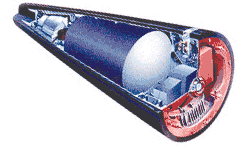W76
| W76 | |
|---|---|
 The W76 warhead and Mk-4 re-entry vehicle (cutaway diagram) – Los Alamos National Labs image | |
| Type | Nuclear weapon |
| Service history | |
| In service | 1978–present |
| Used by | United States and possibly the United Kingdom (see Trident Nuclear Program) |
| Production history | |
| Designer | Los Alamos National Laboratory |
| Designed | W76-0 1973–1978, W76-2 2018 |
| Manufacturer | Pantex Plant |
| Produced | W76-0 1978–1987 (full production), W76-1 2008-2018 (LEP), W76-2 2018-FY2024 |
| No. built | ~3400 |
| Variants | 3 |
| Specifications | |
| Mass | 95 kg[1] |
Detonation mechanism | Contact, airburst |
| Blast yield | 100 kt (W76-0) 90 kt (W76-1) 5–7 kt (W76-2) |
The W76 is a United States thermonuclear warhead, designed for use on the UGM-96 Trident I sea-launched ballistic missiles (SLBMs) and subsequently moved to the UGM-133 Trident II as Trident I was phased out of service. The first variant, the W76 mod 0 (W76-0) was manufactured from 1978 to 1987, and was gradually replaced by the W76 mod 1 (W76-1) between 2008 and 2018, completely replacing the Mod 0 in the active stockpile. In 2018 it was announced that some Mod 1 warheads would be converted to a new low-yield W76 mod 2 (W76-2) version. The first Mod 2 warheads were deployed in late 2019.
History
The warhead was initially manufactured from 1978 to 1987 and designed by Los Alamos National Laboratory. It was initially fitted to the Trident I SLBM system, but after the Rocky Flats plant where its successor the W88 was being made was shut down in 1989 after a production run of only 400 warheads, it was decided to transfer W76 warheads to Trident II.[2]
A life extension program (LEP) for 800 warheads was approved by the US government in 2000, then later increased to 2,000.[3] The purpose of the LEP was extend service life by 20 years and add new safety features. Production on the W76-1 started in September 2008 and the National Nuclear Security Administration completed updating all W76-0 warheads to the W76-1 design in December 2018.[4]
The 2018 Nuclear Posture Review announced that a new variant, the W76-2, would be manufactured.[5] The W76-2 variant is described as a low-yield warhead, estimated at about 5-7 kilotons of TNT equivalent.[6] The National Nuclear Security Administration announced that it had started to manufacture the W76-2 in January 2019. Initial operating capability was expected in the final quarter of 2019,[7] and manufacturing is expected to last through FY2024[8] at the Pantex Plant.[9] According to FAS, the W76-2 warhead was first deployed with USS Tennessee during its late 2019 operational patrol.[10] The US Department of Defense confirmed in February 2020 that W76-2 had been 'fielded'.[11]
The warhead is currently the most numerous weapon in the US nuclear arsenal,[12] having replaced the 50 kt W68 that was fitted to the Poseidon SLBM in that capacity.
Design
The W76-0 had a design yield of 100 kt while its replacement the W76-1 has a yield of 90 kt. The W76-2 has an estimated yield of 5 to 7 kt.[13]
The W76-0 was fitted inside a Mk4 reentry vehicle (reentry body in US Navy parlance) while the W76-1 and -2 are fitted inside the new Mk4A reentry vehicle. Reentry vehicle and warhead weight is estimated to be approximately 95kg.[1]
During the W76-1 LEP, the warhead was fitted with a new MC4700 arming, fuzing and firing (AF&F) system. The MC4700 AF&F system increases warhead kill probabilities against hard targets such as silos and bunkers and achieves this by detonating the warhead over the target if its on-board computer calculates that it has overshot its target. In comparison, a warhead without such a smart fuze would, when overshooting a target, continue flying, leaving the half-sphere above the target where detonating would destroy the target, and crash into the ground where the warhead's impact fuze would detonate the warhead, outside the kill radius.[14]
See also
- RSM-56 Bulava – missile in the Russian arsenal with warheads of comparable yield
- List of nuclear weapons
References
- ^ a b Harvey, John R.; Michalowski, Stefan (21 December 2007). "Nuclear weapons safety: The case of trident". Science & Global Security. 4 (1): 288. doi:10.1080/08929889408426405.
- ^ Sublette, Carey. "The W88 Warhead". Retrieved 7 September 2018.
- ^ Pincus, Walter, "Strategic Plan Extends Life Span Of Nuclear Arsenal", The Washington Post, 19 May 2011, p. 17.
- ^ Work completed on Navy’s upgraded nuclear warhead. Defense News. 24 January 2019.
- ^ https://media.defense.gov/2018/Feb/02/2001872886/-1/-1/1/2018-NUCLEAR-POSTURE-REVIEW-FINAL-REPORT.PDF "Nuclear Posture Review 2018"
- ^ https://www.washingtonpost.com/world/national-security/trump-poised-to-get-new-low-yield-nuclear-weapons/2018/06/13/161b1466-6dac-11e8-9ab5-d31a80fd1a05_story.html "Trump poised to get new low-yield nuclear weapons"
- ^ https://www.theguardian.com/world/2019/jan/28/us-nuclear-weapons-first-low-yield-warheads-roll-off-the-production-line "US nuclear weapons: first low-yield warheads roll off the production line"
- ^ https://fas.org/blogs/security/2018/11/ssmp2018/ "NNSA Plan Shows Nuclear Warhead Cost Increases and Expanded Production"
- ^ Mehta, Aaron (January 28, 2019). "Trump's new nuclear weapon has entered production". Defense News.
- ^ "US Deploys New Low-Yield Nuclear Submarine Warhead". FAS. 29 January 2020. Retrieved 29 January 2020.
- ^ Rood, John. "Statement on the Fielding of the W76-2 Low-Yield Submarine Launched Ballistic Missile Warhead". US Dept of Defense. Retrieved 4 February 2020.
- ^ "The W76 Warhead". www.nuclearweaponarchive.org.
- ^ Kristensen, Hans M.; Korda, Matt (29 April 2019). "United States nuclear forces, 2019". Bulletin of the Atomic Scientists. 75 (3): 122–134. doi:10.1080/00963402.2019.1606503.
- ^ "How US nuclear force modernization is undermining strategic stability: The burst-height compensating super-fuze". Retrieved 8 March 2020.
External links
- W76 information at Nuclear Weapon Archive
- W76 information at Global Security
- Imminent House Vote on New Low-Yield Nuclear Weapon | Union of Concerned Scientists
